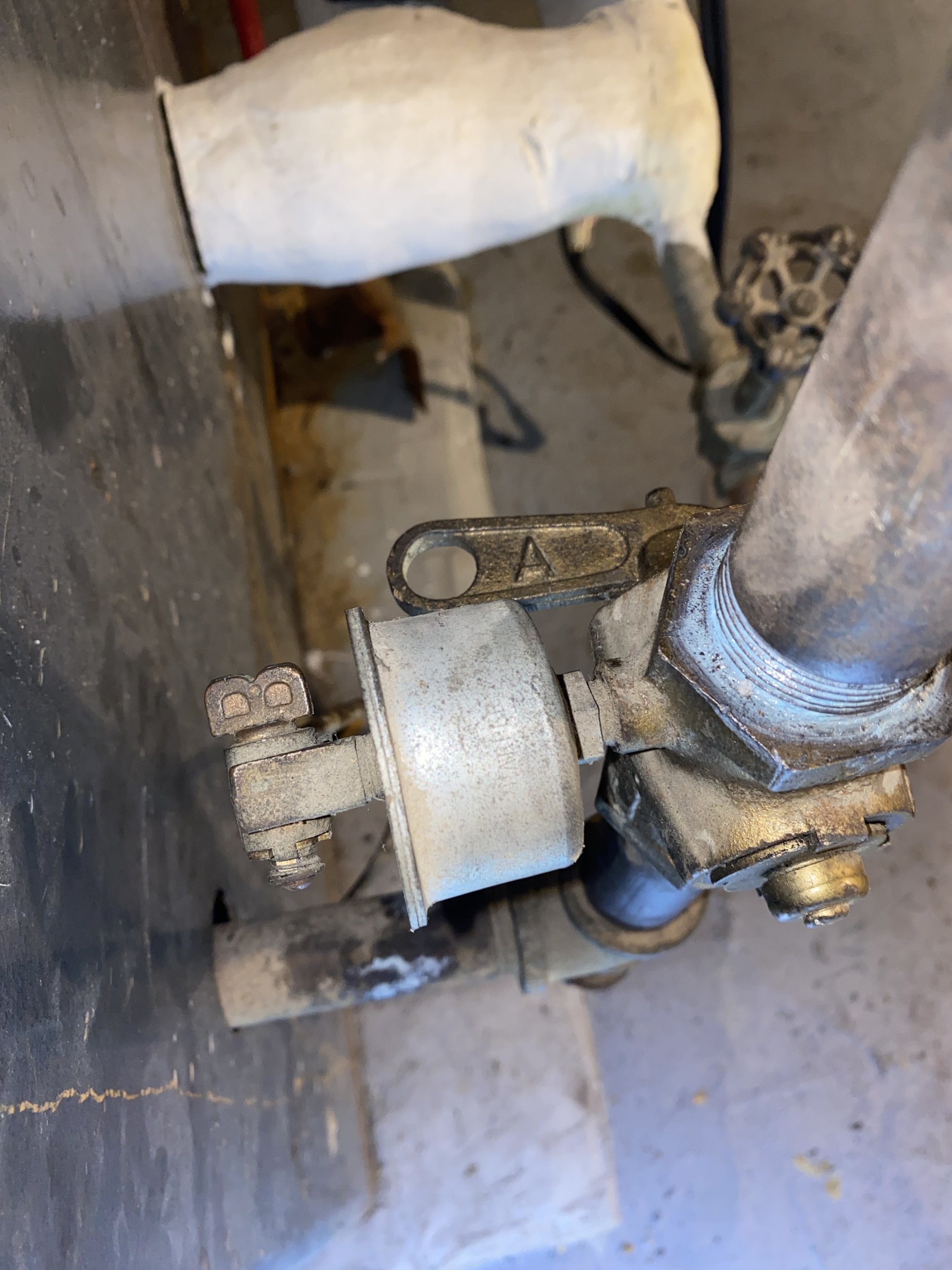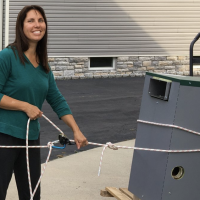Weil Mclain H-9 boiler from the 60's...
Hey everyone bare with me on this one… So I get a call for a few gas leaks leading to the boiler. I get on-site and see an old Weil Mclain H-9 boiler natural gas… I fix the leaks and proceed to visually inspect the boiler and fire it up and hit a snag… It has a pilot line coming from a manual open close valve on the main gas line(closed because national grid closed it when they went for the gas smell). So the only way to light the pilot is to open it obviously, well there's nothing that controls the gas flow once you open the valve it just dumps gas to the pilot and you light it! So if the pilot flame goes out it continues to dump gas!! No way this can be the original design but the pilot valve definitely looks original. Someone replaced the gas valve in 2019 and it sure seems they made a few modifications. This boiler also has an automatic pilot little box that has its own thermocouple looking rod by the pilot that has 24 volts sitting at it and when it senses the pilot it sends 24volts out through the safeties and so on. Obviously I can rip the gas train out and put something with a standing pilot but this baby is old and not sure it would be worth it. Anyway's there's no way I will leave this as is because there's nothing that controls the pilot gas!! Anyone ever run into one of these before? I'll attach all the pictures I have. Thanks.
Comments
-
Thats how things were done!
0 -
Pec that’s wild! No control of pilot gas if the pilot goes out. Very interesting,thanks for the input.
0 -
-
Hey Scott it’s my first time seeing this setup so I was takin back some. When I purposely blew the flame out and the gas kept coming I turned it off until I come up with a plan. I wouldn’t be able to sleep if I left it as is even though it’s worked for 60 plus years lol… There’s a good amount of gas that comes out of that pilot line. Cool to see and learn something new, appreciate your feedback.
1 -
If you look closely at the last photo you posted, the vents on the main electric gas valve and the main gas regulator are also vented to the "combustion area." I think the idea was that if one of these rubber diaphragms leaked it would also just ignite or not and go up the chimney.
0 -
I did notice that also, I was going to ask about that but didn’t want to ask too many questions at once. I just can’t bring myself to feel comfortable leaving it as is I don’t think. I did notice someone along the way rewired a couple things on that little terminal strip in the picture, at-least it looks like they did.
1 -
You could convert the system to utilize a thermocouple or spark ignition. This would take a little ingenuity and some money. Then the question arises, is it worth investing money into a sixty year old boiler?
Another thing to consider, is do the controls still work properly? I would be a little concerned with the wiring too. At the very least, check all the controls and safeties.
0 -
Definitely agree on would it be worth it or not.. I’d hate to convert and have them put $ into it then have the block leak or something down the road. I always go out of my way to keep the old stuff running and not selling new but this case may be different. Either way it’s cool to see something new to me. I just can’t get past the pilot setup. I’ll price out a different valve setup for the hell of it and see what direction they want to go. The Maxitrol regulator even Maxitrol tech support said we don’t make that and I have no information lol…
the input, this site always rocks.
0 -
I have seen my fair share of these. They were mostly converted before I got to them. Definitely scary. I guess thermocouples weren't always a thing. In regards to whether or not it's worth fixing up, that is 100% up to whoever is writing the check. Just give them the scoop that they are investing in a boiler that has been around for a while and might be very close to retirement. They write the check so they get to choose
0 -
Completely agree Steam, thanks for the input.
0 -
That setup does use a thermocouple- it is connected to the White-Rodgers "automatic pilot" control, which cuts off the electricity to the main gas valve if the pilot goes out. But it is not a "100% shutoff" system since the pilot gas is not cut off if the pilot goes out.
Converting that would require a combination gas valve that could handle at least 560,000 BTUH. ISTR Robertshaw makes these. You'd reroute the thermocouple and pilot tube to the new combination gas valve, remove the separate pilot valve and plug the opening.
All Steamed Up, Inc.
Towson, MD, USA
Steam, Vapor & Hot-Water Heating Specialists
Oil & Gas Burner Service
Consulting2 -
Standard pre total shutoff rule gas train. Not really enough gas from the pilot to be unsafe unless you are really trying to collect it or don't follow the lighting instructions. The relighter is just a high voltage transformer that sparks if there is not flame and grounds out the flame is present and providing a current path.
1 -
I think those cut off wires on the terminal strip are for the relighter, looks like it maybe isn't hooked up anymore.
0 -
Oh, it isn't a relighter, it is WR's version of a baso switch.
0 -
Just make sure the MV doesn't open if the pilot is out, light it, and write up your bill for your gas leak repairs.
0 -
That was common to have a "hot" or "active flowing" pilot train at that time. Yes, the intent was that the NG would just go up the chimney if not burned. Some gas valves and regulators had vent tubes that are terminated at the pilot to burn off any excess with the same logic in mind. Now any such vents have to be vented outside.
More of a concern if the system is propane/LPG.
I worked on a larger boiler from that time frame, 960,000 btu input, with 16 burners.
It had 4 standing pilots that all had to be burning. If any one failed the main valve would not open.
I timed how long if the pilots failed, before the main would shut down.
It was a long 40+ seconds…….a lot of gas would pass in this nursing home in that time.
I posted here about a method of faster shut down perhaps using a flame sensor.
I was informed, perhaps by Tim, that would be inadvisable. Because altering the original safety would put any bad event in my liability arena.
One of those "you fixed it, you own it". So it was tested several times and at every servicing I performed……..and I shudder to think that this was originally running on propane/LPG for the first 10 years before NG showed up in that town.
1 -
Vented outside or equiped with a vent limiter device.
0 -
Great info guys really appreciate it. Yes it does have the thermocouple that will shut the main off/not let it come on but obviously nothing for the pilot. I’ll see if he wants to leave it as it’s been for 60 years, maybe convert or replace.
0 -
If that gas valve was replaced relatively recently it should have been replaced with a modern combination valve but I don't see the current setup as particularly unsafe, just a little less safe than a modern system.
0 -
Matt someone replaced the valve in 2019, still the original Regulator though. I did brush out the block because I guess Grid picked up some CO,it definitely needed it but I haven’t retested it yet.
0 -
If you read the pilot lightening instructions in the one picture it’s not even close to what’s there, not sure if it ever was,any thoughts?
0 -
If it were LPG it would have had a total shutoff valve, probably a separate valve before the pilot and the main valve or a switch and pilot valve that was held open with a thermocouple after you pressed the button. LPG has been more or less always total shutoff because it is heavier than air and tends to collect. Might have been made when total shutoff for all gas heating equipment was adopted in some locations and not others.
0 -
ISTR standing pilot safeties were allowed 3 minutes before they cut the main burners off. That's scary……….
All Steamed Up, Inc.
Towson, MD, USA
Steam, Vapor & Hot-Water Heating Specialists
Oil & Gas Burner Service
Consulting0 -
I was googling thermocouple controlled pilot valves earlier today for total shutoff. Found 1 just no details on size or flow or anything, might call them tomorrow. Heats off here in NY for a while so there’s time to research and maybe keep her alive for another 60 years.
0 -
There were 1000's of these free flowing pilots in the past and the worst I have ever heard of was some HO might have smelled NG and was concerned.
I would let it go for the reasons I mentioned above.
Also this will raise concern for the HO and may even suspect you of up-sales as they have had no problem for 60 years. JMHO
0 -
There are Baso thermocouple valves that shut off all the gas with a pilot tap after the shutoff. I don't recommend modifying it unless you replace wit with a modern combination valve for liability reasons. Modern valves have a double seat that the old gas trains didn't. If you just make it total shutoff pilot and leave the rest of the train you aren't bringing it up to current standards.
0 -
Not sure how to respond to individual comments but I agree Jughne and Matt 100% with your last comments. Grateful for all the input from everyone. Always learning!
0
Categories
- All Categories
- 87.3K THE MAIN WALL
- 3.2K A-C, Heat Pumps & Refrigeration
- 61 Biomass
- 427 Carbon Monoxide Awareness
- 119 Chimneys & Flues
- 2.1K Domestic Hot Water
- 5.8K Gas Heating
- 115 Geothermal
- 165 Indoor-Air Quality
- 3.7K Oil Heating
- 76 Pipe Deterioration
- 1K Plumbing
- 6.5K Radiant Heating
- 395 Solar
- 15.6K Strictly Steam
- 3.4K Thermostats and Controls
- 56 Water Quality
- 51 Industry Classes
- 50 Job Opportunities
- 18 Recall Announcements













